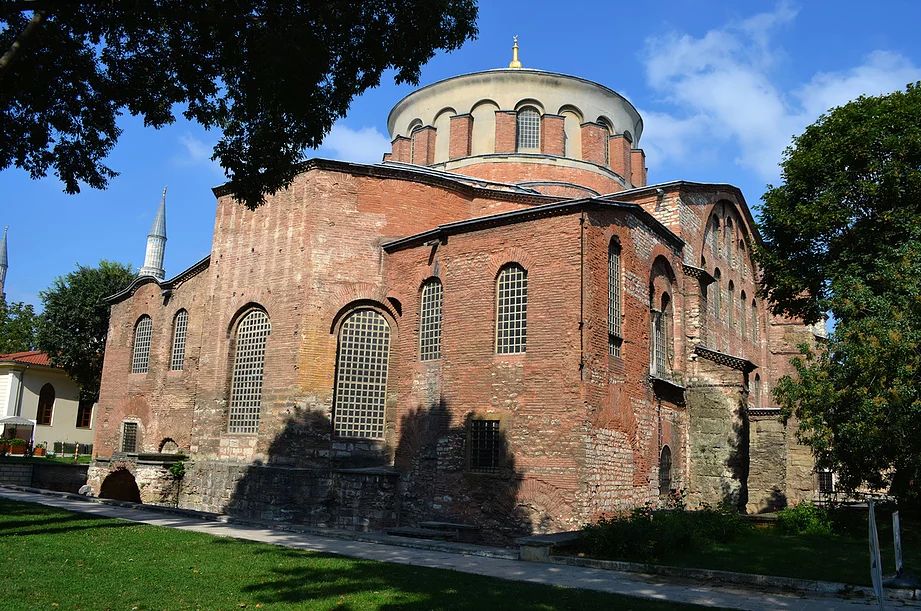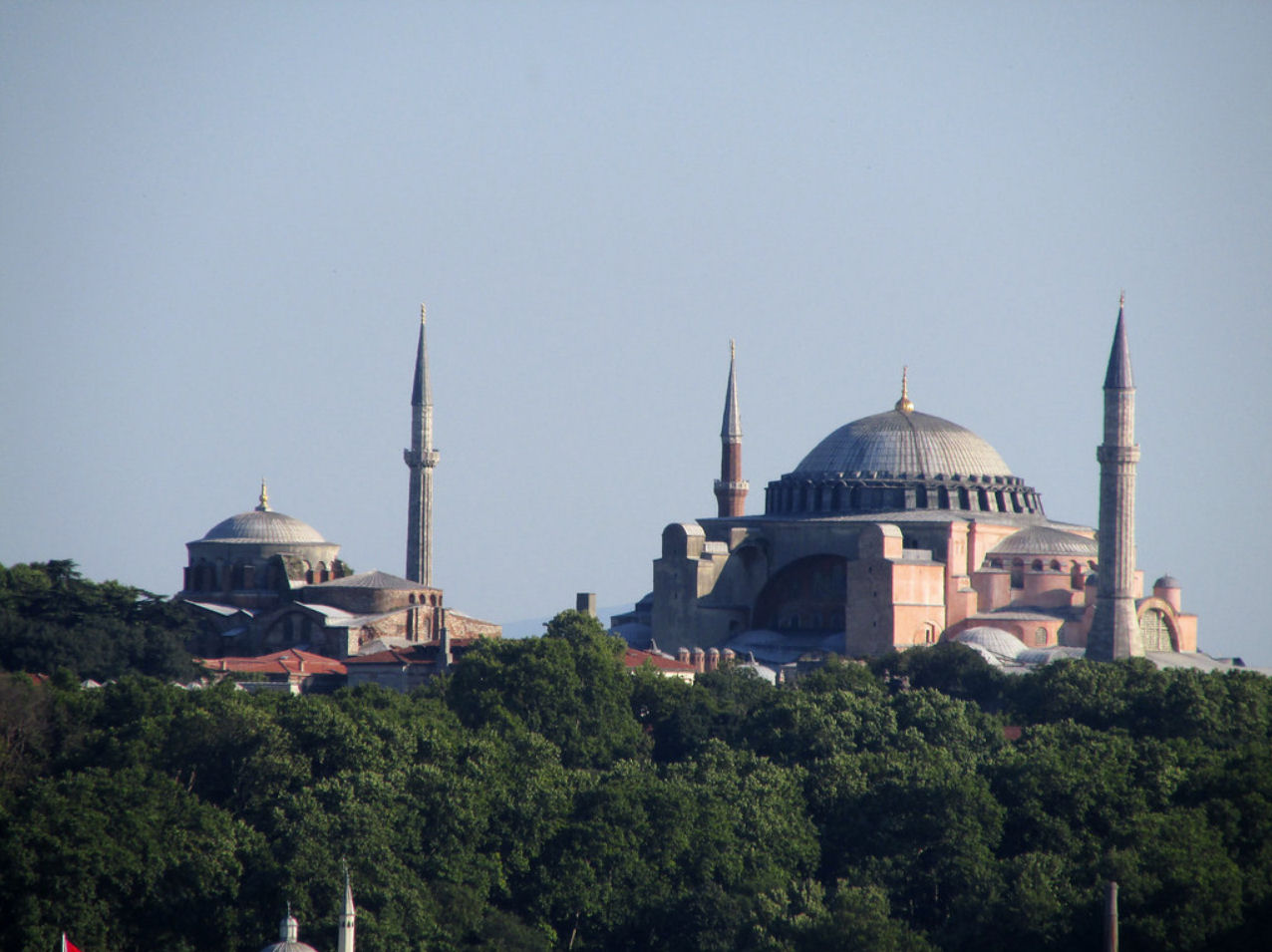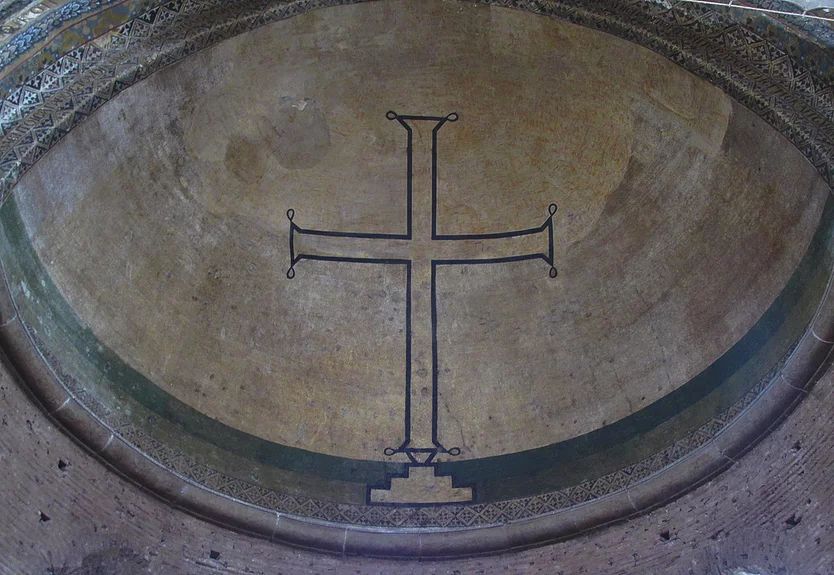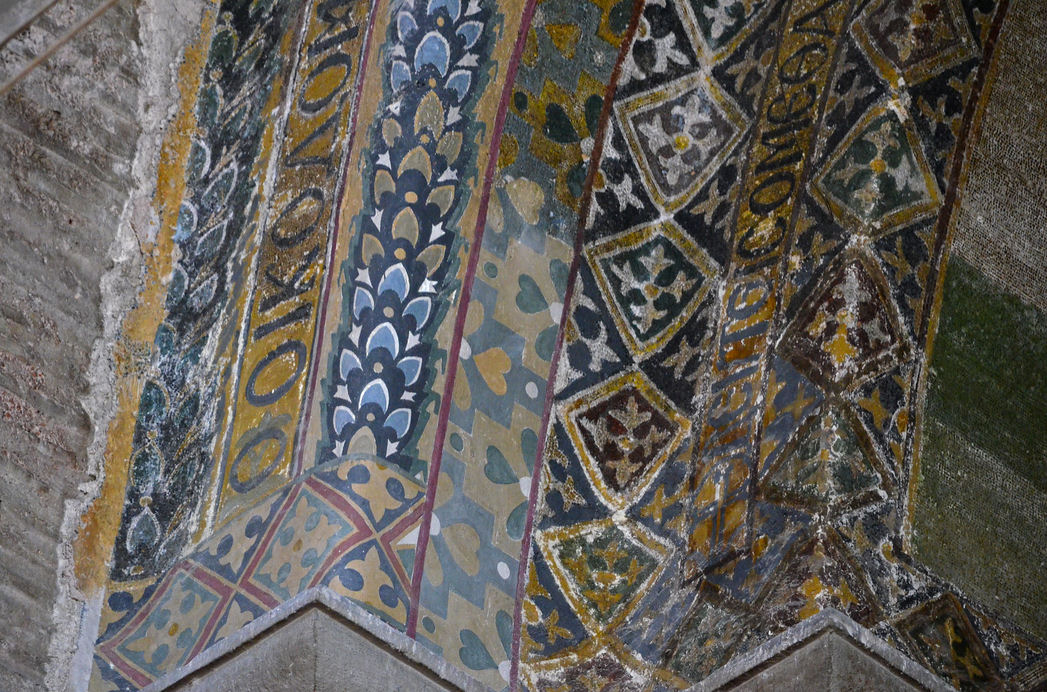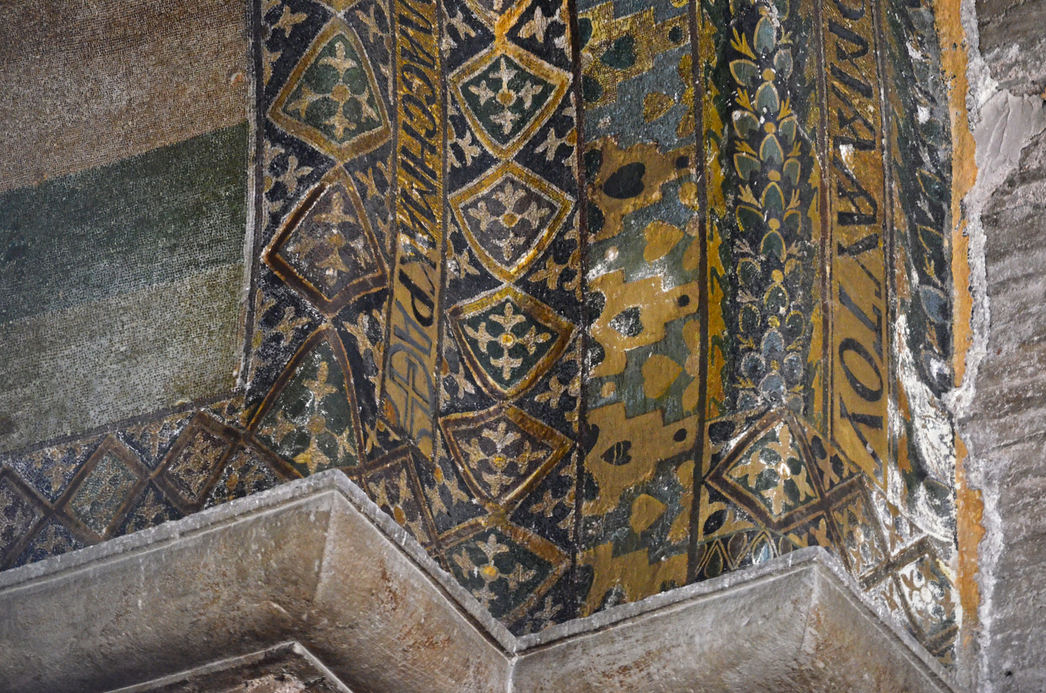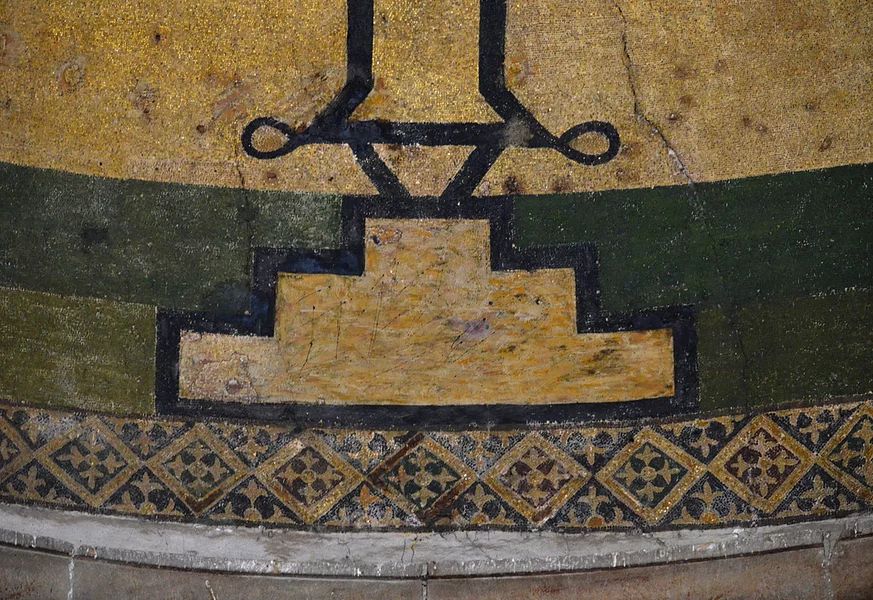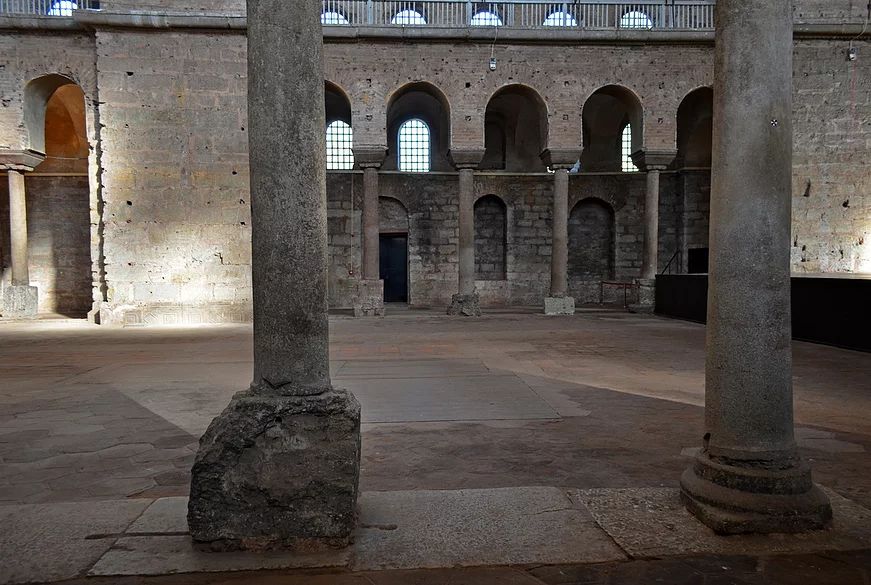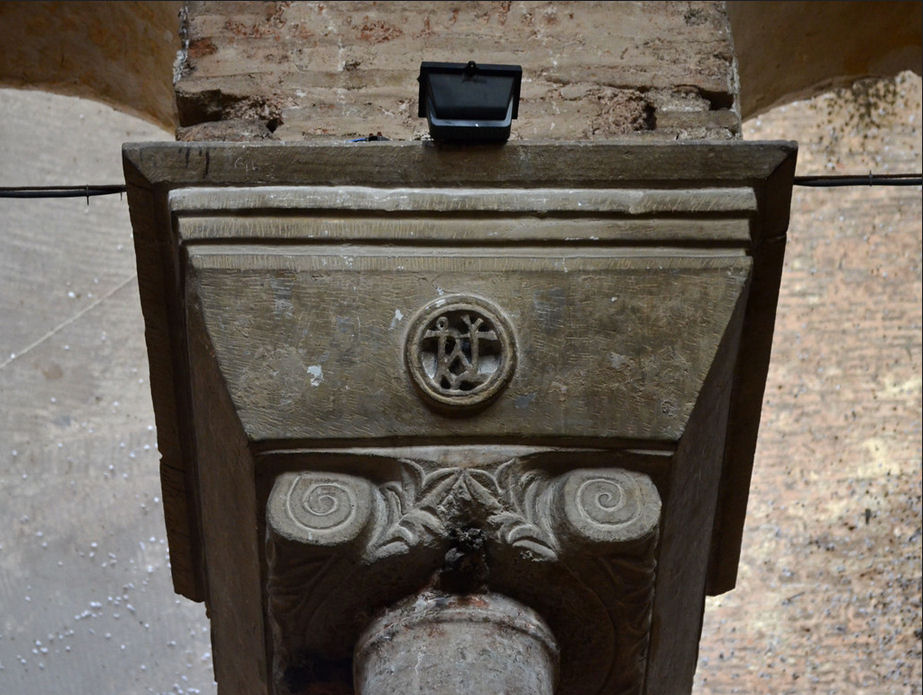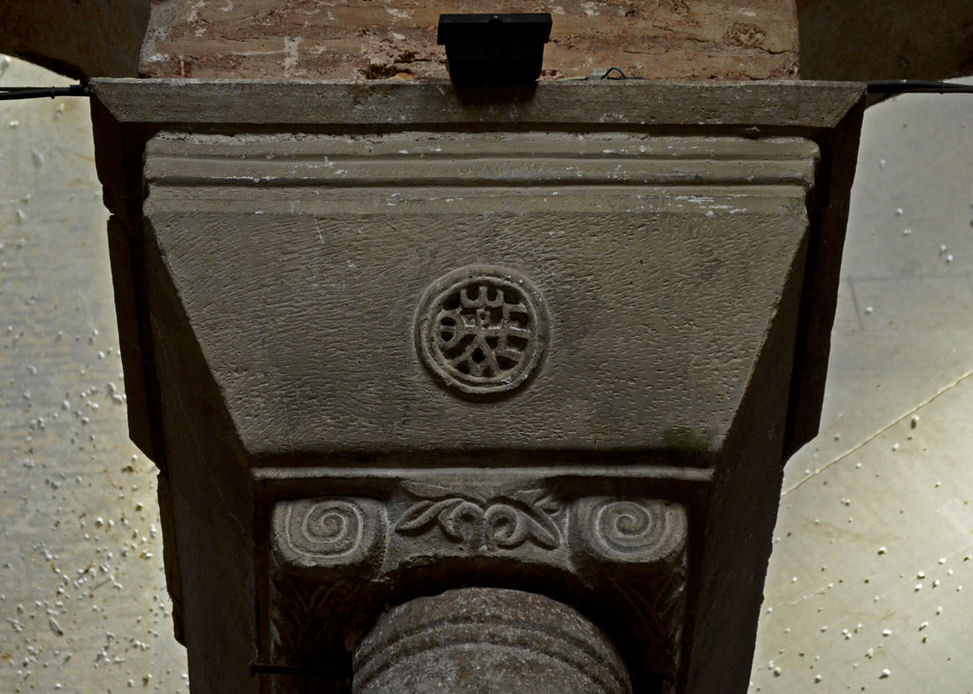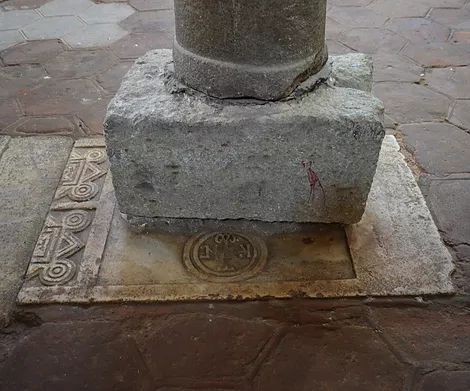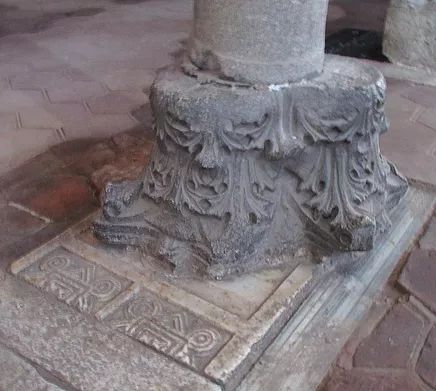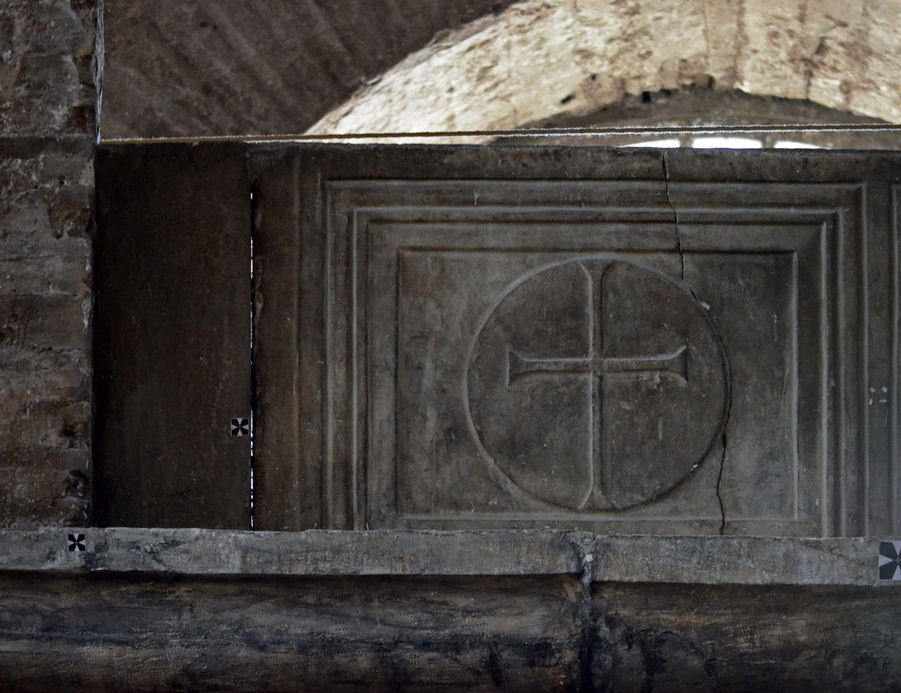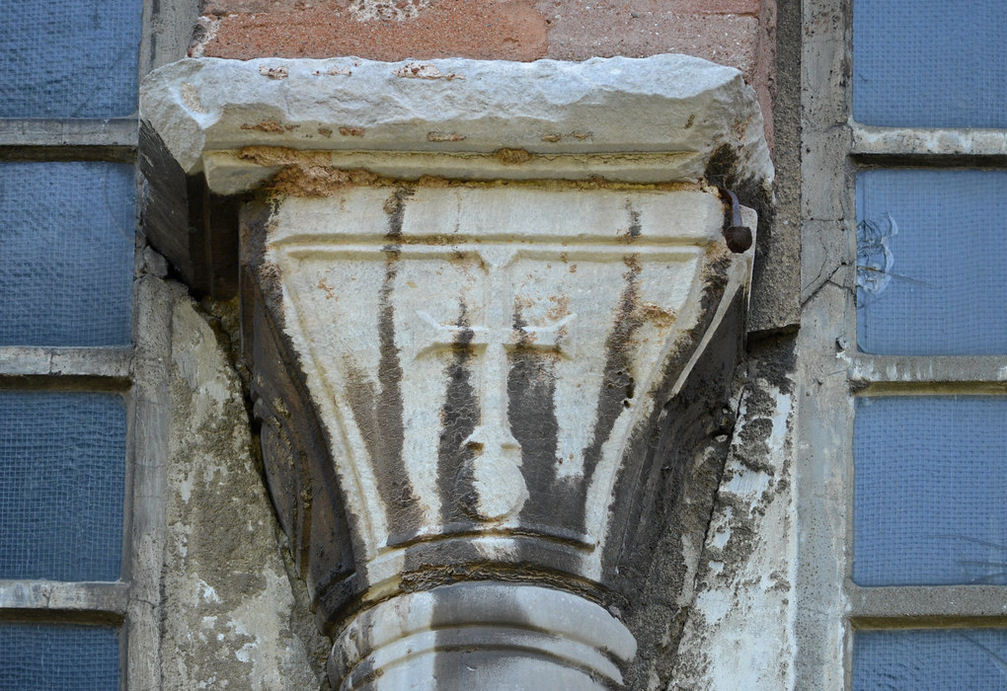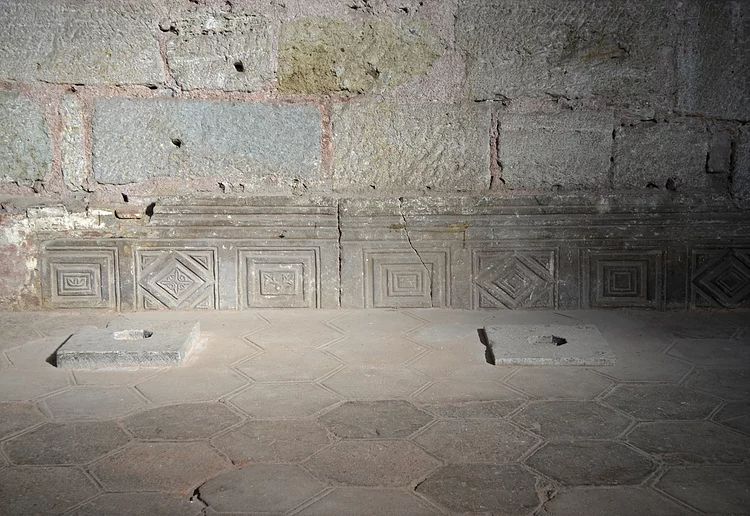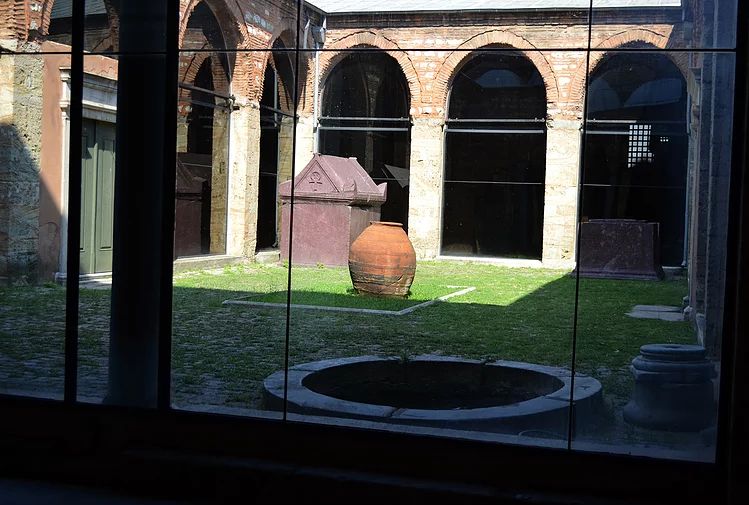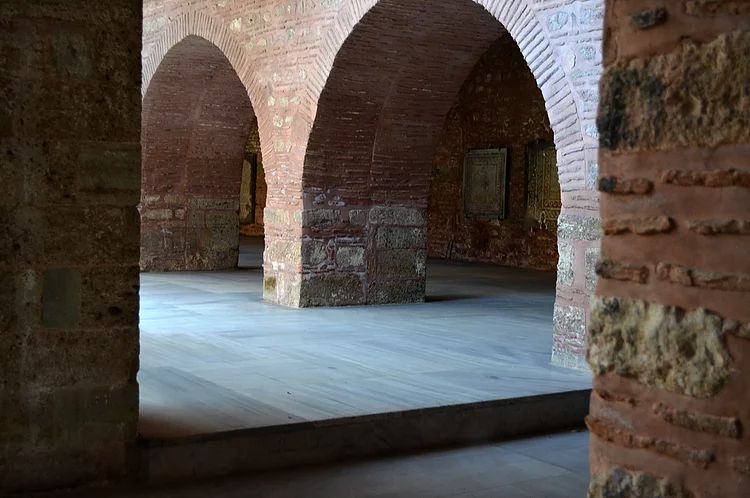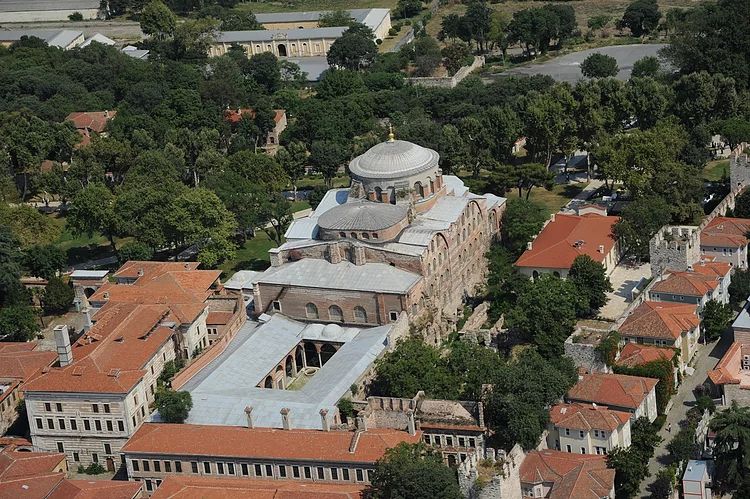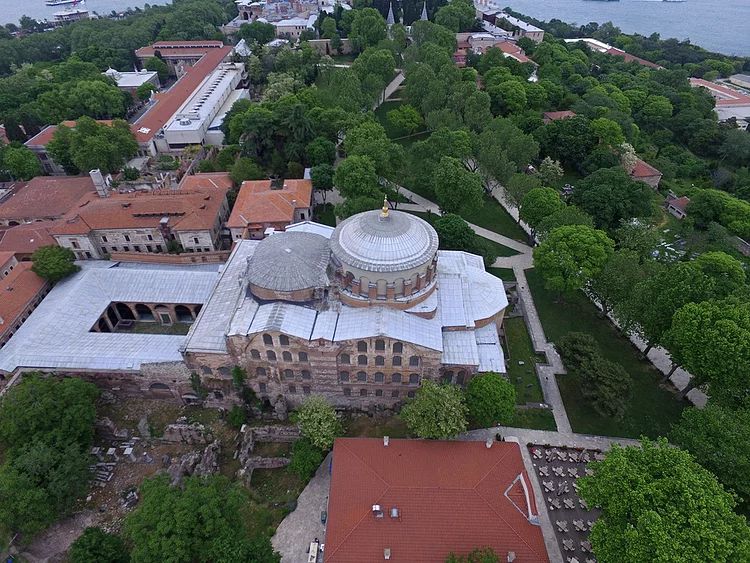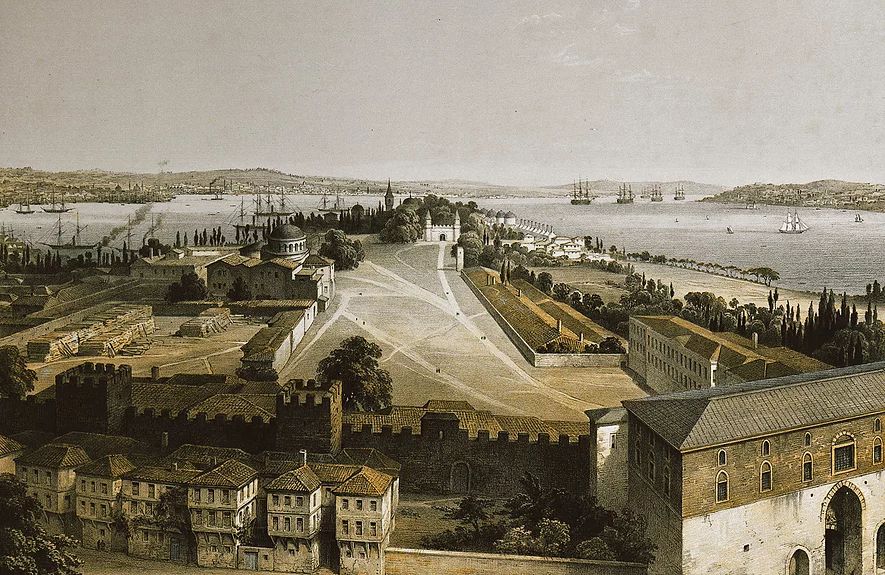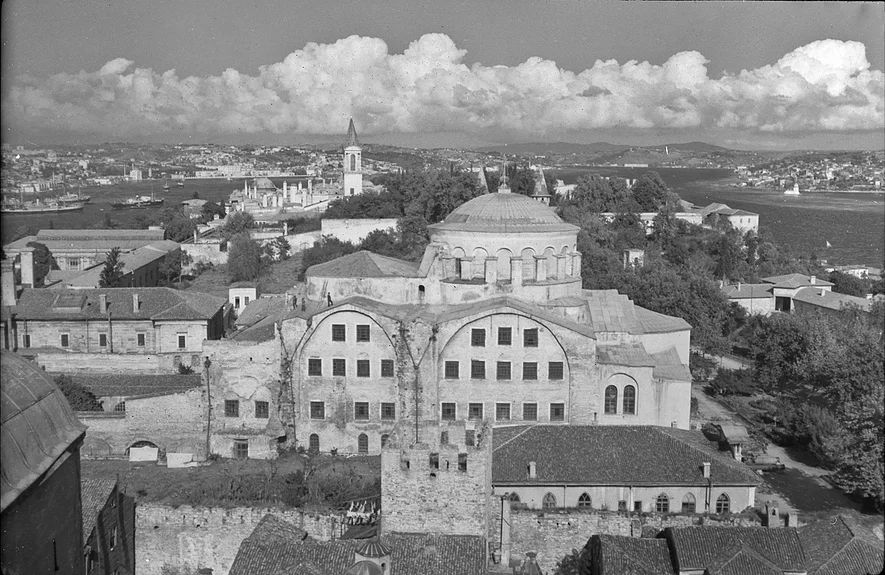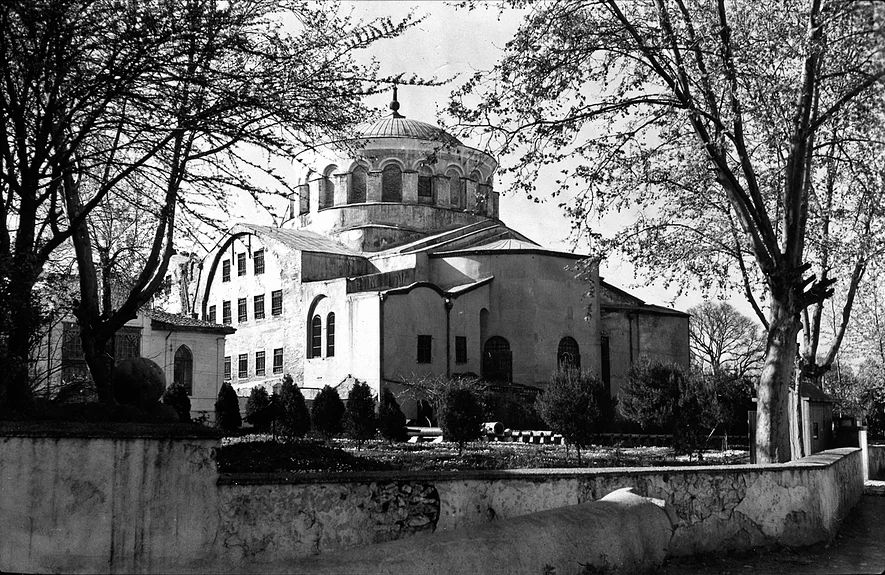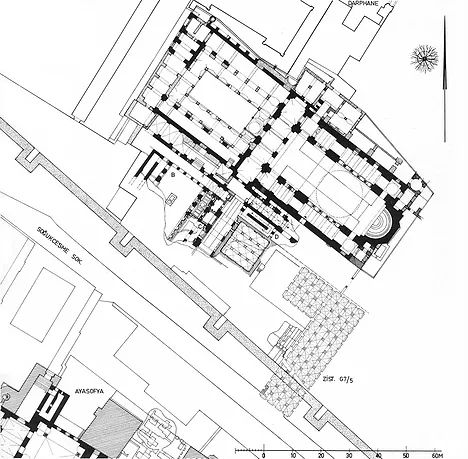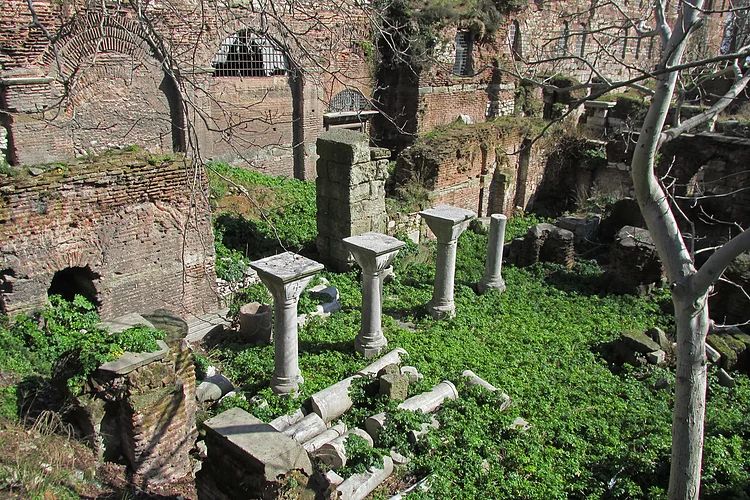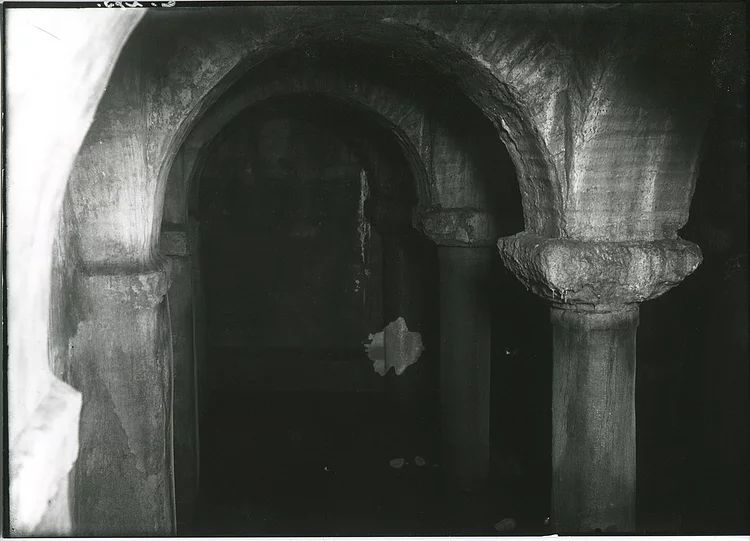Hagia Eirene
(The Byzantine Legacy. Created by David Hendrix Copyright 2016)
Копирано от: https://www.thebyzantinelegacy.com/hagia-eirene
(Коментари от Асен Чилингиров, март 2019 г.:
Изпращам ЗА АРХИВИРАНЕ много ценна частна информация от интернет за църквата "Св. Ирина" в Константинопол - без данните за църквата като част от св. Константиновата Троица, но с много други изворни и фотографски документации.
Подборката е много ценна и се вързва с останалите материали - дори и новите, където археолозите се чудят коя е св. Ирина. Може да дадете и там (БЦ 2) линк към тази подборка. Не зная кой любител е правил подборката, но тя е далече по-професионална от нашите "именити археолози". Поставете я заедно с датирането и патронажа на СфСвСф.)
- (Overview)
- Outer Inscription on the Triumphal Arch
- Inner Inscription on the Triumphal Arch
- Monograms
- From Socrates’ Ecclesiastical History
- From Buildings by Procopius
References — Resourses
|
- (Overview)
The Church of Hagia Eirene (Greek Αγία Ειρήνη “Divine Peace”) is a Byzantine church located within in the first courtyard of Topkapı Palace in modern Istanbul. After the Hagia Eirene built by Constantine burned down, it was rebuilt by Justinian in the 6th century and extensively rebuilt by the Iconoclast emperor Constantine V in the 8th century, when the apse was decorated by a simple mosaic cross. After functioning as an arsenal or armory for centuries in the Ottoman era, it became Istanbul’s first museum in the 19th century.
The first church dedicated to Hagia Eirene is generally attributed to Constantine (306-337). There are other sources, though, that suggest that there was already a small church here that Constantine (or his son Constantius II) rebuilt or expanded. Hagia Eirene, which was also known as the “Old Church” (Αρχαία Εκκλησία), served as the cathedral of Constantinople until the inauguration of Hagia Sophia in 360. Following the ordination of Paul the Confessor as the bishop of Constantinople in Hagia Eirene around 337, there was a series of conflicts between Orthodox and Arian Christians, eventually resulting in the death of 3150 (? The phrase should probably read: "eventually resulting in Paul's death in 350"). Hagia Eirene was within the same enclosure of Hagia Sophia following its construction, and was part of the episcopal complex. It is possible that the First Ecumenical Council of Constantinople in 381 was held in Hagia Eirene. The church probably temporarily functioned as the cathedral at the beginning of the 5th century, following the destruction of Hagia Sophia in 404. The relics of St. John Chrysostom, brought to Constantinople from Asia Minor in 438, were first housed in Hagia Eirene before being transferred to the Holy Apostles.
Hagia Eirene was rebuilt by Justinian (527–565) in a form of a domed basilica after Constantine’s Hagia Eirene burned down in the Nika Revolt in 532. The church then was part of a major construction project undertaken by Justinian that included more than 30 other churches, such as Hagia Sophia and Sergius and Bacchus. The adjacent structure to the south of Hagia Eirene is perhaps the ruins of the Hospital of Sampson which Justinian had rebuilt around the same time. Hagia Eirene was repaired after a fire ravaged the surrounding neighborhood, destroyed the church’s atrium and damaged its narthex in 564. The church was severely damaged by the earthquake of 740 and probably reconstructed by the Iconoclastic emperor Constantine V (740-775) during which time the famous Iconoclastic cross was added. It is possible that, in restoring this church, Constantine V was associating himself with Constantine, the originally founder of the church, as well as Justinian and Theodora, whose monograms appear on the capitals in the arcades. In 859 a council held in Hagia Eirene deposed of Photius and declared Ignatius to be the legitimate Patriarch of Constantinople. There are only a limited number of references to Hagia Eirene through the rest of the Byzantine era, such as references to it being a possession of Hagia Sophia following the Byzantine reconquest of the city from the Latins in 1261.
Hagia Eirene was apparently briefly used by Christians working in the court of Mehmet II following the Ottoman conquest of the city in 1453. A wall was build that separated it from Hagia Sophia, when Topkapı Palace was expanded to include Hagia Eirene. As the building was located in the courtyard of the palace near the barracks of the Janissaries, it served as an arsenal (known as İç Cebehane “Inner Arsenal”). In 1726, during the reign of Ahmed III, it functioned as an armory (known as Dar-ül Esliha “House of Weapons”). From 1846 to 1874, it housed the Museum of Antiquities and subsequently as the Military Museum. In 1916/17, several porphyry sarcophagi were transported from here to the Museum of Antiquities (now Istanbul Archaeological Museums) and finally in 1946, the rest of the collection (save the limited number of artifacts in the atrium) were moved to allow the building to be researched. The structure has been affiliated with Hagia Sophia Museum since 1939. After serving primarily as a concert hall for many years, it was opened to the public as a museum in 2014.
The plan of Hagia Eirene is around 57 x 32 meters (not including the atrium), and the diameter of the main dome is around 16 meters. Its masonry mainly consists of thin red bricks and mortar. The architectural features of the church are complicated by the fact it was restored several times. While there is some debate about the details, it is generally held that the lower sections of the church date to the reign of Justinian, while the superstructure of the church was restored by Constantine V after the earthquake of 740 (now dated by dendrochronology after 753). In addition, the remains of several structures (including a round structure) are located north and east of the church, and seem to date to the 6th or 8th century. During the Ottoman era, the columns supporting the galleries were replaced by smaller columns supported by block and the atrium was altered. The Ottomans also built a new gallery as well as a new main entrance.
Justinian’s Hagia Eirene was probably a domed basilica that consisted of a dome resting on pendentives raised above an elongated nave, with a narthex to the west, an apse to the east, two aisles separated from a nave by columns at ground level and vaulted galleries on three sides. The walls of Justinian’s church were probably covered by marble revetment, while it seems that the mosaics in the narthex also date to this period. There are also several capitals in the aisles bearing the monograms of Justinian and Theodora. The reconstruction of Constantine V followed the basic plan and scale of Justinian’s church, however several key changes were made to the superstructure, including adding a dome over the western bay. The most important improvement is the transverse barrel vaults over the galleries better supporting the dome on pendentives. The rebuilding of the barrel vaults of the gallery resulted in the church becoming a cross-domed basilica. Traces of vegetation set among dense geometric patterns centered on jeweled crosses can be seen in the south aisle. Chancel Proconnesian marble panels, once used as the chancel screen dividing the clerical bema from the worshippers in the naos, are now embedded in the floor under the columns. One of these panels includes the monogram of Constantine V.
The mosaic decoration in the apse is arguably the most noteworthy feature of Hagia Eirene as it is a rare example of Iconoclastic art. Proponents of Iconoclasm, including Constantine V, rejected the use of figural imagery in religious art, substituting figures with symbols. Instead of the depictions of the Theotokos and Christ Child or or Christ Pantokrator, as would become a dominant form of Byzantine church decoration, Constantine V commissioned a non-figural decorative program that focused on veneration of the True Cross. The mosaic cross in the apse consists of a stark black cross with flared ends on a golden mosaic background. It stands on three-stepped platform next to bans of greenish mosaics. The apse is framed mosaics with geometric patterns and foliage. There are also two mosaic inscriptions in the triumphal arch (from the Psalms and Amos) that were significantly altered (with the use of paint) during a restoration. |
Hagia Eirene (left) and Hagia Sophia (right)
Apse with Iconoclastic Cross

From George (1913)
- Outer Inscription on the Triumphal Arch
Ο ΟΙΚΟΔΟΜѠΝ ΕΙC ΤΟΝ ΟΙΚΟΝ CΟΥ ΚΑΙ ΑΝΑΒΑCΙΝ ΑΥΤΟΥ ΚΑΙ ΤΗΝ ΕΠΑΓΓΕΛΙΑΝ ΤΟΥ ΑΓΙΟΥ ΠΝΕΥΜΑΤΟC ΕΥ ΗΜΑC ΗΛΠΕΙCΑΜΕΝ ΕΙC ΤΟ ΟΝΟΜΑ ΑΥΤΟΥ
[Original mosaic in bold script, the rest painted during 19th century restoration]
Badly restored inscription probably based on Amos 9:6 (NIV)
ὁ οἰκοδομῶν εἰς τὸν οὐρανὸν ἀνάβασιν αὐτοῦ καὶ τὴν ἐπαγγελίαν αὐτοῦ ἐπὶ τῆς γῆς θεμελιῶν, ὁ προσκαλούμενος τὸ ὕδωρ τῆς θαλάσσης καὶ ἐκχέων αὐτὸ ἐπὶ πρόσωπον τῆς γῆς κύριος ὁ θεὸς ὁ παντοκράτωρ ὄνομα αὐτῷ.
“He builds his lofty palace in the heavens and sets its foundation on the earth; he calls for the waters of the sea and pours them out over the face of the land—the LORD is his name.”
In addition to referencing Amos 9:6, it has also been suggested that it paraphrases Psalms 32:21 and Isaiah 26:8.
- Inner Inscription on the Triumphal Arch
+ΔΕΥΤ ΕΙCΟΜΕΘΑ ΕΝ ΤΟΙC ΑΓΑΘΟΙC ΤΟΥ ΟΙΚΟΥ ΟΟΥ ΑΓΙΟC Ο ΝΑΟC CΟΥ ΘΑΥΜΑCΤΟC ΕΝ ΔΙΚΑΙΟCΥΝΗ ΕΠΑΚΟΥCΟΝ ΗΜѠΝ Ο ΘC Ο CΗΡ ΗΜѠΝ Η ΕΛΠΙC ΠΑΝΤѠΝ ΤωΝ ΠΕΡΑΤѠΝ ΤΗC ΓΗC ΚΑΙ ΤѠΝ ΕΝ ΘΑΛΑCCΗ ΜΑΧΡΑ+
[Original mosaic in bold script, the rest painted during 19th century restoration]
This badly restored inscription seems to be based on Psalms 65 (64):4-5 (NIV)
μακάριος ὃν ἐξελέξω καὶ προσελάβου κατασκηνώσει ἐν ταῖς αὐλαῖς σου. πλησθησόμεθα ἐν τοῖς ἀγαθοῖς τοῦ οἴκου σου. ἅγιος ὁ ναός σου, θαυμαστὸς ἐν δικαιοσύνῃ. ἐπάκουσον ἡμῶν, ὁ θεὸς ὁ σωτὴρ ἡμῶν, ἡ ἐλπὶς πάντων τῶν περάτων τῆς γῆς καὶ ἐν θαλάσσῃ μακράν.
“Blessed are those you choose and bring near to live in your courts! We are filled with the good things of your house, of your holy temple. You answer us with a awesome and righteous deeds, God our Savior, the hope of all the ends of the earth and of the farthest seas, who formed the mountains by your power, having armed yourself with strength, who stilled the roaring of the seas, the roaring of their waves, and the turmoil of the nations.”
Columns and capitals with crosses
Monograms of Justinian and Theodora
- Monograms
The monograms of Justinian and emperor (basileos and augustus) at Hagia Eirene are box monograms. The monograms of Justinian (IOYCTINIANOY) are based on the letter N, with the letter I contained in its upright. Both the letters T and a square C (Sigma) are to the right, with the letter A inserted within the left side of the N (in more than one variation), and the OY diphthong crowning the monogram. The monograms of ΒΑCΙΛΕѠΣ (basileos) are box mongrams based on B and E with Ѡ (Omega) above, while the monogram of ΑΥΓΟΥΣΤΟΥ (augustus) have the letter A at the center, with T on the left, a square C (Sigma) on the left and the OY diphthong crowning the monogram. The monograms of Theodora (ΘEOΔѠPAC) at Hagia Eirene are of the cruciform type, with the letters Θ (Theta), E, Ѡ (Omega), and A being attached to the cross. The O is incorporated in the Θ (Theta), while in some cases the Δ is formed by added a bar beneath the A.
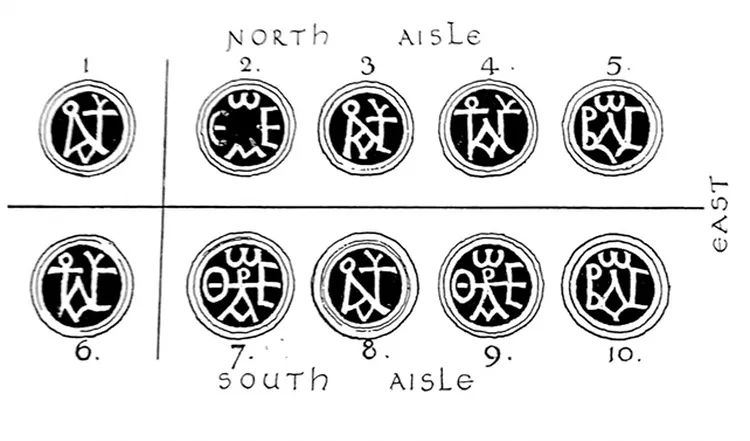
Drawings of monograms by George
Spolia under columns, including monogram of Constantine V
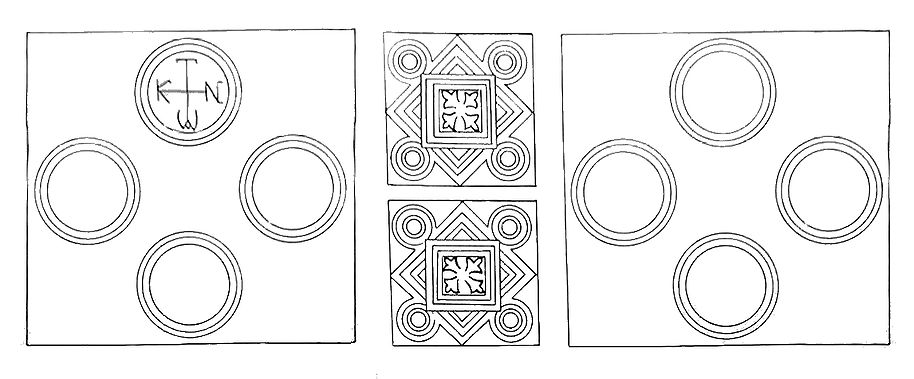
Reconstruction of Chancel with Monogram of Constantine V by T. Ulbert
- From Socrates’ Ecclesiastical History
When the Emperor Constantius, who then held his court at Antioch, heard that Paul had again obtained possession of the episcopal throne, he was excessively enraged at his presumption. He therefore despatched a written order to Philip, the Prætorian Prefect, whose power exceeded that of the other governors of provinces, and who was styled the second person from the emperor, to drive Paul out of the church again, and introduce Macedonius into it in his place. Now the prefect Philip, dreading an insurrectionary movement among the people, used artifice to entrap the bishop: keeping, therefore, the emperor’s 43 mandate secret, he went to the public bath called Zeuxippus, and on pretense of attending to some public affairs, sent to Paul with every demonstration of respect, requesting his attendance there, on the ground that his presence was indispensable. The bishop came; and as he came in obedience to this summons, the prefect immediately showed him the emperor’s order; the bishop patiently submitted condemnation without a hearing. But as Philip was afraid of the violence of the multitude—for great numbers had gathered around the building to see what would take place, for their suspicions had been aroused by current reports—he commanded one of the bath doors to be opened which communicated with the imperial palace, and through that Paul was carried off, put on board a vessel provided for the purpose, and so sent into exile immediately. The prefect directed him to go to Thessalonica, the metropolis of Macedonia, whence he had derived his origin from his ancestors; commanding him to reside in that city, but granting him permission to visit other cities of Illyricum, while he strictly forbade his passing into any portion of the Eastern empire. Thus was Paul, contrary to his expectation, at once expelled from the church, and from the city, and again hurried off into exile. Philip, the imperial prefect, leaving the bath, immediately proceeded to the church. Together with him, as if thrown there by an engine, Macedonius rode seated in the same seat with the prefect in the chariot seen by everybody, and a military guard with drawn swords was about them. The multitude was completely overawed by this spectacle, and both Arians and Homoousians hastened to the church, every one endeavoring to secure an entrance there. As the prefect with Macedonius came near the church, an irrational panic seized the multitude and even the soldiers themselves; for as the assemblage was so numerous and no room to admit the passage of the prefect and Macedonius was found, the soldiers attempted to thrust aside the people by force. But the confined space into which they were crowded together rendering it impossible to recede, the soldiers imagined that resistance was offered, and that the populace intentionally stopped the passage; they accordingly began to use their naked swords, and to cut down those that stood in their way. It is affirmed that about 3150 persons were massacred on this occasion; of whom the greater part fell under the weapons of the soldiers, and the rest were crushed to death by the desperate efforts of the multitude to escape their violence. After such distinguished achievements, Macedonius, as if he had not been the author of any calamity, but was altogether guiltless of what had been perpetrated, was seated in the episcopal chair by the prefect, rather than by the ecclesiastical canon. Thus, then, by means of so many murders in the church, Macedonius and the Arians grasped the supremacy in the churches. About this period the emperor built the great church called Sophia, adjoining to that named Irene, which being originally of small dimensions, the emperor’s father had considerably enlarged and adorned. In the present day both are seen within one enclosure, and have but one appellation.
Imperial Porphyry Sarcophagi in the atrium
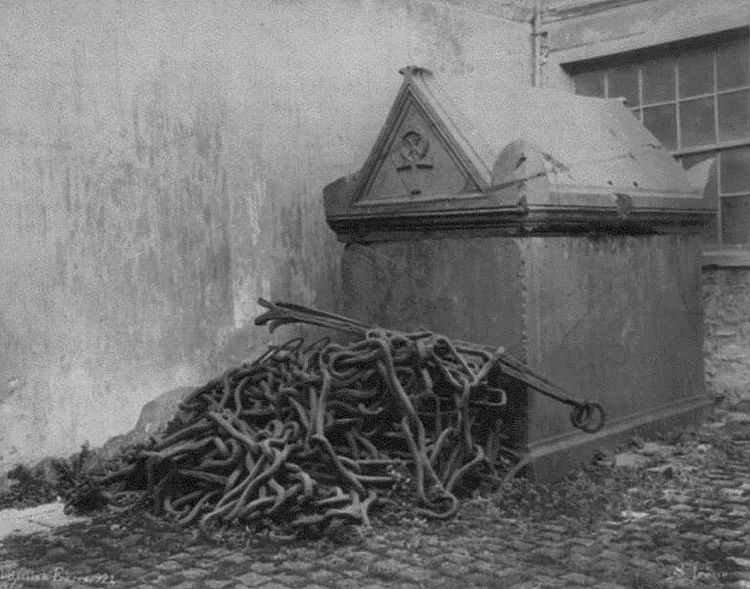
Golden Horn chain previously located in the atrium
Mosaic museum in the atrium
- From Buildings by Procopius
The church called after Eirene, which was next to the Great Church and had been burned down together with it, the Emperor Justinian rebuilt on a large scale, so that it was scarcely second to any of the churches in Byzantium, save that of Sophia. And between these two churches there was a certain hospice, devoted to those who were at once destitute and suffering from serious illness, those who were, namely, suffering in loss of both property and health. 15 This was erected in early times by a certain pious man, Samson by name. And neither did this remain untouched by the rioters, but it caught fire together with the churches on either side of it and was destroyed. The Emperor Justinian rebuilt it, making it a nobler building in the beauty of its structure, and much larger in the number of its rooms. He has also endowed it with a generous annual income of money, to the end that through all time the ills of more sufferers may be cured.
Aerial photo by Kadir Kir
Aerial photo by István Pi Tóth
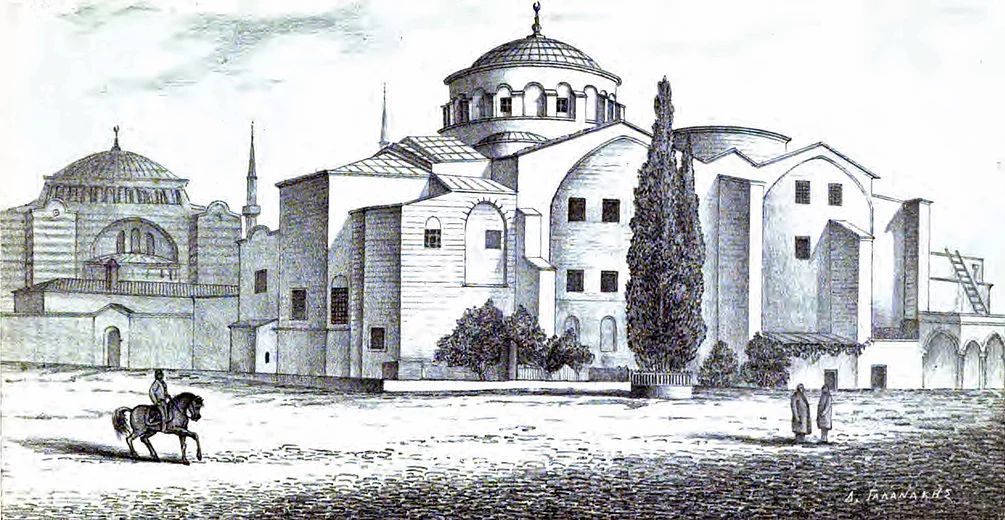
From Byzantine Studies by Paspates (1877)
Gaspard Fossati (1852)
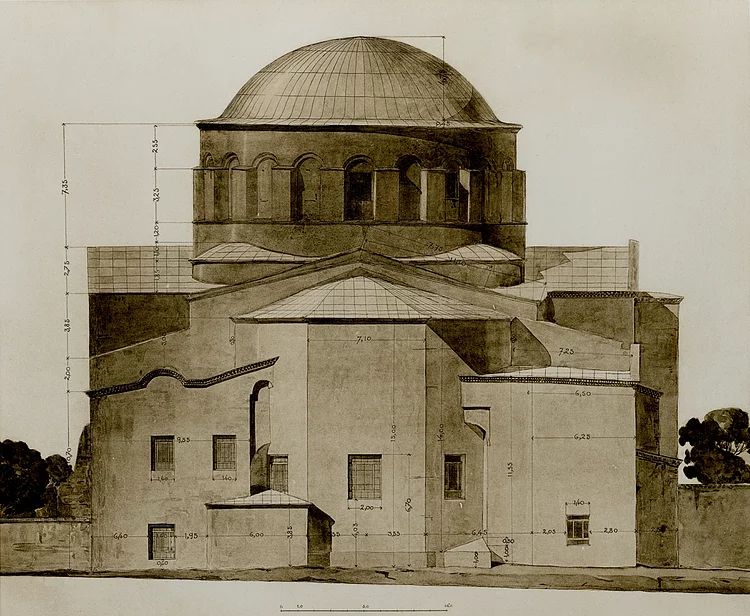
Ebersolt & Thiers (1910)
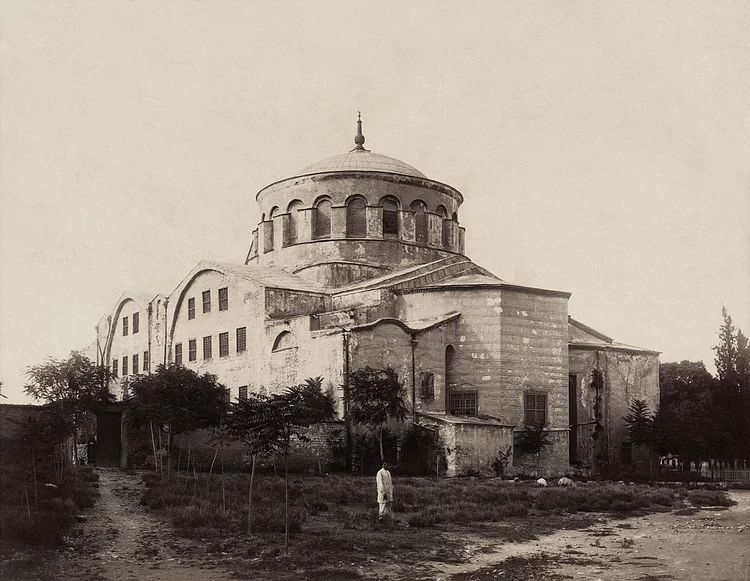
Photo by Sébah & Joaillier
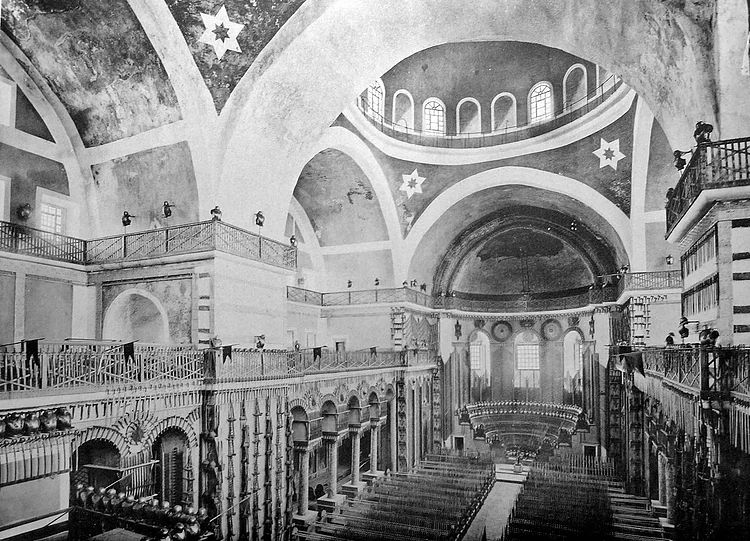
Photo by Gurlitt (1912)
From the Nicholas V. Artamonoff Collection
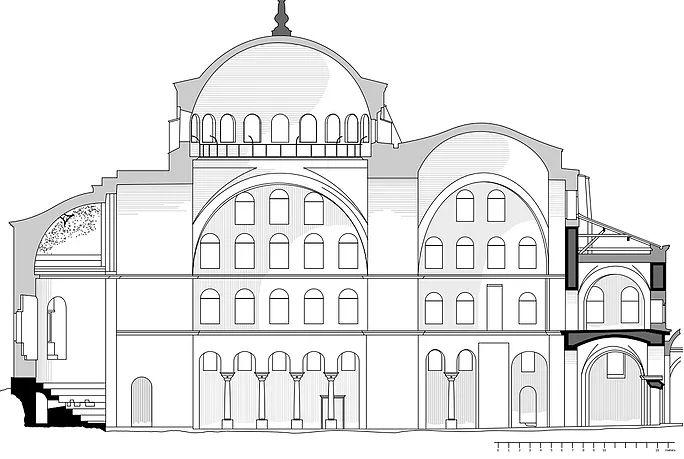
From Millingen (1912)
Plan by Müller-Wiener
Remains of structure near Hagia Eirene might be the Hospital of Sampson
The L-shaped cistern, discovered in 1927, dates to Late Antiquity and has a total of 52 columns. The main section of the cistern measures around 54 x 13 m, with 3 rows of 13 columns.
Possible photo L-shaped cistern by David Talbot-Rice
From Birmingham East Mediterranean Archive Flickr
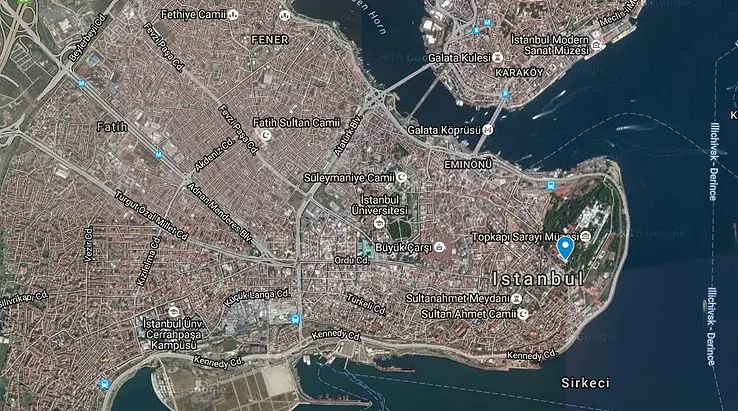
See Map of Byzantine Churches of Constantinople
References
Byzantine Architecture by Cyril Mango
La géographie ecclésiastique de l'Empire byzantin by R. Janin
Bildlexikon zur Topographie Istanbuls: Byzantion, Konstantinupolis, Istanbul by Müller-Wiener
Byzantium in the Iconoclast Era 680-850: The Sources by Leslie Brubaker and John Haldon
Byzantine Religious Architecture 582-867 by Vincenzo Ruggieri
Brickstamps of Constantinople by Jonathan Bardill
“The Apse Mosaic of Hagia Eirene: The Splendor of Iconoclasm” by Jordan Pickett
“Some notes about Hagia Eirene” (From ANAMED Summer Programme in Byzantine Epigraphy) by Antonio Felle
The Church of Saint Eirene at Constantinople by W.S. George
Die Irenenkirche in Istanbul: Untersuchungen zur Architektur by U. Peschlow
İstanbul'da Bizans Dönemi Sarnıçlarının Mimari Özellikleri ve Kentin Tarihsel Topografyasındaki Dağılımı by Kerim Altuğ
Byzantine Churches in Constantinople: Their History and Architecture by Alexander Van Millingen
Les Eglises de Constantinople by Ebersolt and Thiers
Oxford Dictionary of Byzantium edited by Alexander Kazhdan
The Oxford Handbook of Byzantine Studies edited by Cormack, Haldon, & Jeffreys
The Cambridge Companion to the Age of Justinian edited by Michael Maas
Primary Sources
Ecclesiastical History by Socrates Scholasticus (translated by Philip Schaff)
Buildings by Procopius translated by H.B. Dewing
Resources
Hagia Eirene Album (Byzantine Legacy Flickr)
Hagia Irene (Topkapı Palace Museum)
Hagia Eirene (Nicholas V. Artamonoff Collection)
Blog with aerial photos by Kadir Kir
Aerial photos by István Pi Tóth (Flickr)
The Byzantine Legacy
Created by David Hendrix Copyright 2016
